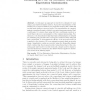Free Online Productivity Tools
i2Speak
i2Symbol
i2OCR
iTex2Img
iWeb2Print
iWeb2Shot
i2Type
iPdf2Split
iPdf2Merge
i2Bopomofo
i2Arabic
i2Style
i2Image
i2PDF
iLatex2Rtf
Sci2ools
121
click to vote
AMDO
2010
Springer
2010
Springer
Estimating 3D Pose via Stochastic Search and Expectation Maximization
In this paper an approach is described to estimate 3D pose using a part based stochastic method. A proposed representation of the human body is explored defined over joints that employs full conditional models learnt between connected joints. This representation is compared against a popular alternative defined over parts using approximated limb conditionals. It is shown that using full limb conditionals results in a model that is far more representative of the original training data. Furthermore, it is demonstrated that Expectation Maximization is suitable for estimating 3D pose and better convergence is achieved when using full limb conditionals. To demonstrate the efficacy of the proposed method it is applied to the domain of 3D pose estimation using a single monocular image. Quantitative results are provided using the HumanEva dataset which confirm that the proposed method outperforms that of the competing part based model. In this work just a single model is learnt to represent...
| Added | 12 Jan 2011 |
| Updated | 12 Jan 2011 |
| Type | Journal |
| Year | 2010 |
| Where | AMDO |
| Authors | Ben Daubney, Xianghua Xie |
Comments (0)

